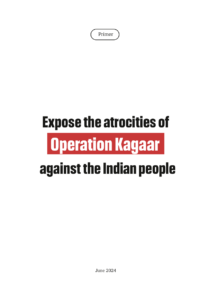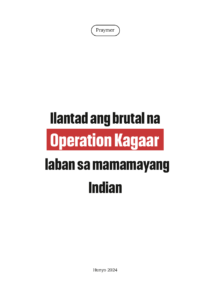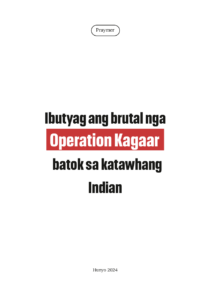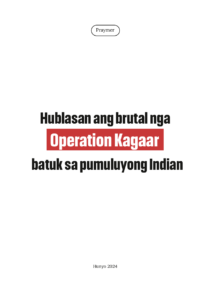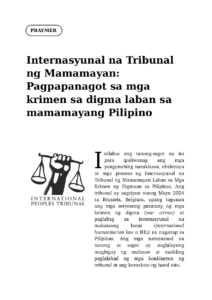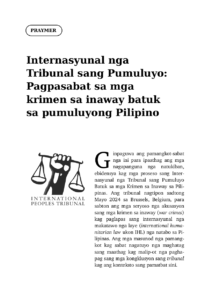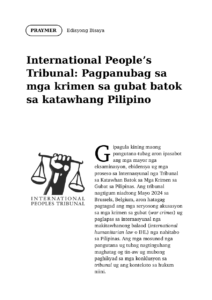(Primer) Expose the atrocities of Operation Kagaar against the Indian people
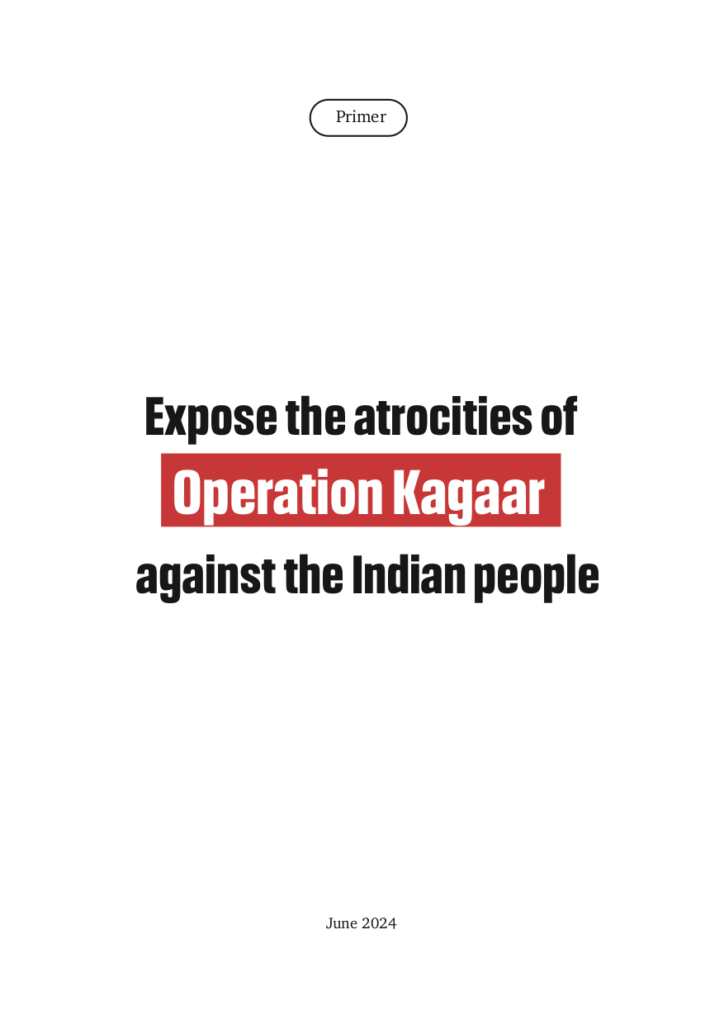
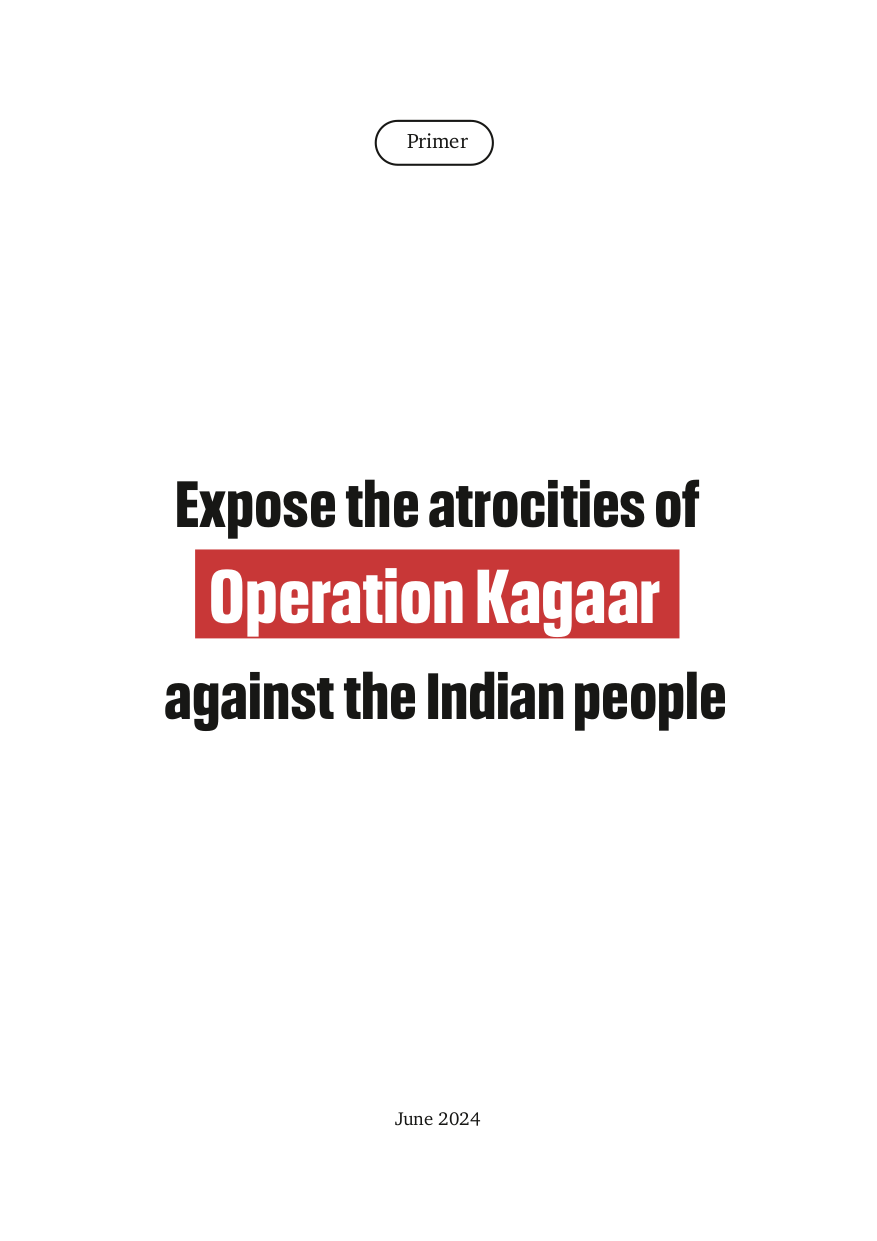 DOWNLOAD The Central Committee of the Communist Party of the Philippines recently proclaimed June 20-July 20 as a Month of Solidarity for the Indian people’s struggle, particularly the Adivasi masses’ fight against Operation Kagaar. In line with this, the Information Bureau publishes this primer to inform all Party members, revolutionary forces, and Filipino people about the Modi regime’s fascist atrocities in India.
DOWNLOAD The Central Committee of the Communist Party of the Philippines recently proclaimed June 20-July 20 as a Month of Solidarity for the Indian people’s struggle, particularly the Adivasi masses’ fight against Operation Kagaar. In line with this, the Information Bureau publishes this primer to inform all Party members, revolutionary forces, and Filipino people about the Modi regime’s fascist atrocities in India.
The pronouncement is a response to the call made by the Communist Party of India (Maoist) and its international support group the International Committee to Support the People’s War in India (ICSPWI), for a campaign to oppose Operation Kagaar and support for the Adivasi people’s resistance, and the advancement of the people’s war in India as the primary means to thwart the regime’s suppression campaign.
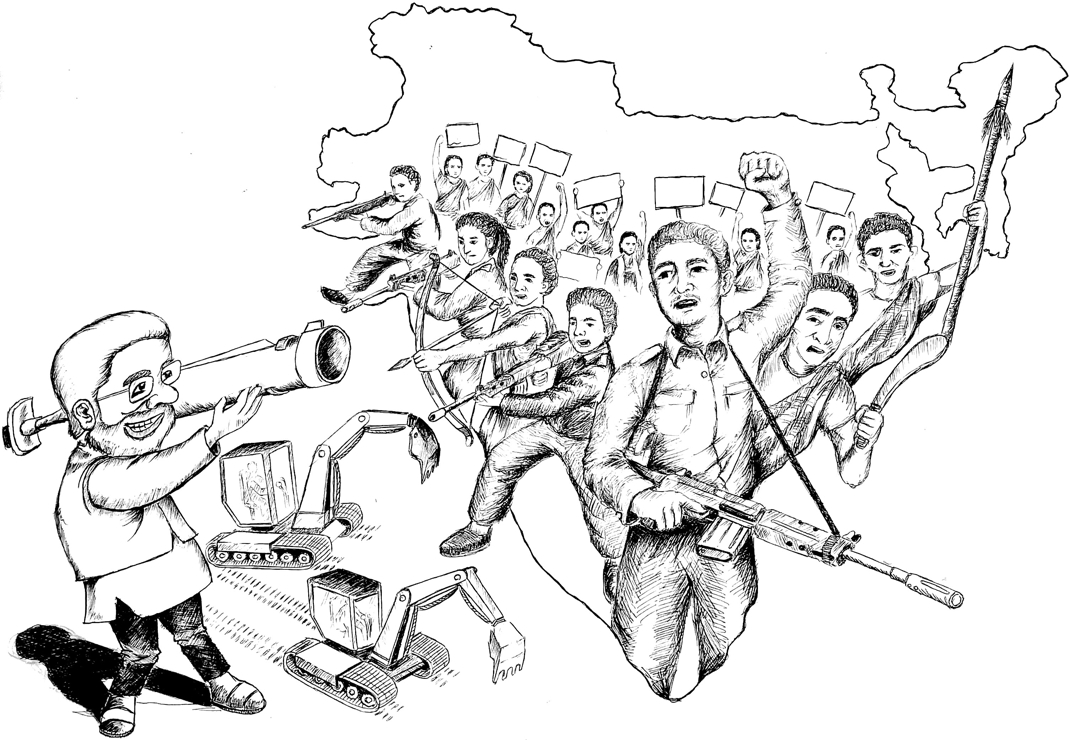
I. What is Operation Kagaar?
Operation Kagaar is a military operation being implemented by the reactionary central and state governments of India. It was launched in January in Central India to suppress the armed resistance led by the Communist Party of India (Maoist). This is part of the broader counterinsurgency operation known as Operation SAMADHAN-Prahar, started in 2017.
The word “kagaar” means “final” in Hindi, signifying the government’s aim to eliminate the Maoist revolutionary movement once and for all.
The operation’s main focus is the Abujhmaad (Maad) region, a densely forested and mountainous area in the southern state of Chhattisgarh, considered a Maoist stronghold. Maad is within the larger Dandakaranya forest belt spanning the states of Chhattisgarh, Odisha, Telangana, and Andhra Pradesh. This region is home to a significant Adivasi (indigenous) population.
In Operation Kagaar’s initial salvo in January, the Indian government mobilized a 10,000-strong paramilitary force, 3,000 of which were poured in from other states into Maad. These forces were stationed in six paramilitary camps in the area, outnumbering local residents by a ratio of three to seven.
Under this operation, at least 130 civilians and revolutionaries have been killed by the Indian state from January to May this year. This operation blatantly violates international humanitarian law, conventions on war, and special protections for vulnerable sectors in conflict zones.
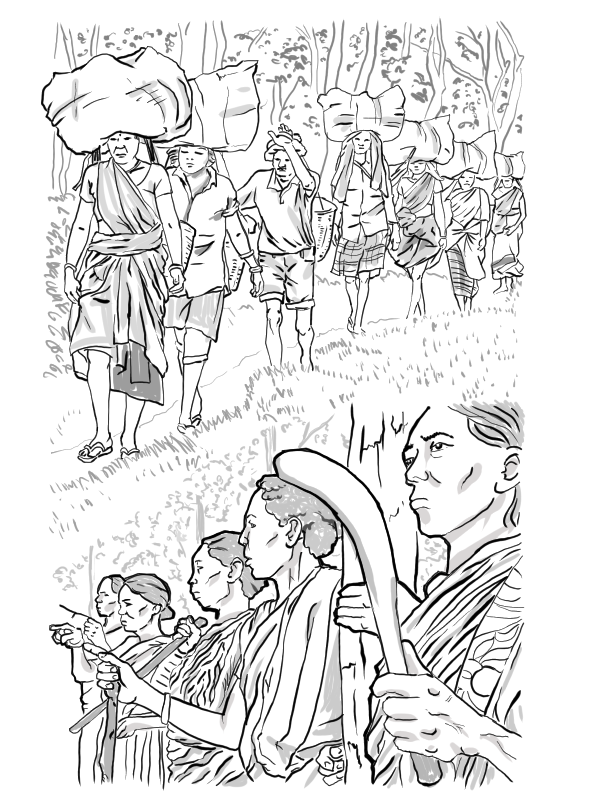
II. The Adivasi and their resistance
Under the pretext of defeating the Maoists, Operation Kagaar targets all parties, organizations and individuals who dare to oppose the state. The primary victims are the Adivasi people, who have been fighting for decades to protect their environment, ancestral lands, and livelihood.
Comprising over 8% of India’s population (104.2 million, roughly the size of the Philippines’ population), the Adivasis are national minorities consisting of more than 600 indigenous tribes, primarily located in Central India. Their lives are deeply intertwined with the forests, which cover one-fourth of India’s territory.
The Adivasi ancestral lands are rich in natural resources, including iron, copper, gold, zinc, lead, manganese, chromite, and bauxite. These forests also serve as a source of timber and other wood products, as well as grazing land and large-scale plantation farms.
The reactionary Indian state has long carried out genocide against the Adivasis. Countless cases of their eviction, land grabbing, and entry of large corporations into their lands have been recorded. These have intensified under Narendra Modi’s fascist Brahmanic Hindutva (fascism against religious minorities and lower strata) regime.
Along with Operation Kagaar is the corporatization and exploitation of India’s rich forests by large companies. They seek to quell the people’s resistance against the plunder of the country’s natural resources by foreign multinational corporations.
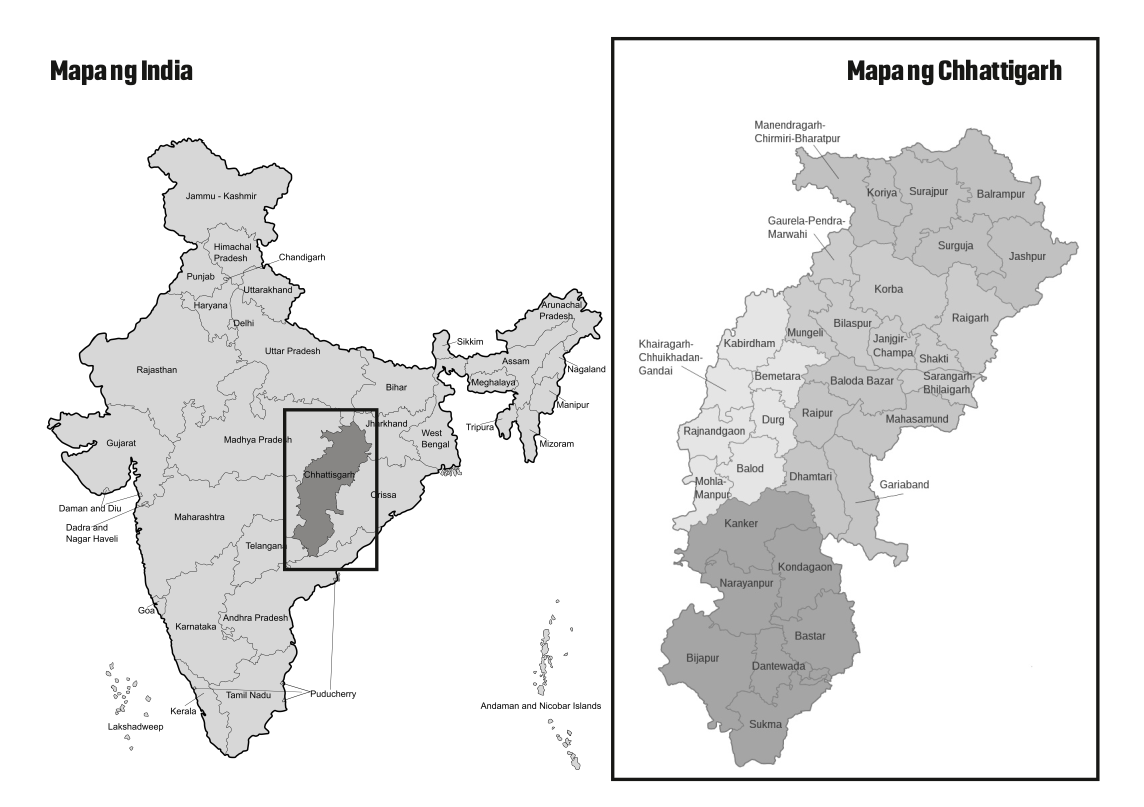
III. Cases of human rights violations
Over the past five months, democratic organizations have recorded 130 victims of extrajudicial killings, or nearly seven per week. Many of the killings are being passed off as “encounters” against the People’s Liberation Guerrilla Army (PLGA) of the CPI (Maoist).
There is also rising number of cases of arbitrary arrests, rape of women, forced surrender as Maoists, indiscriminate firing, bombing, and other human rights violations recorded under Operation Kagaar. Some of the most flagrant incidents include:
- January 1: Killing of a 6-month-old infant by indiscriminate firing by state forces in Bijapur, Chhattisgarh
- January 16: Abduction and killing of three Adivasi in Nendra, Bijapur, Chhattisgarh
- January 30: Shooting and killing of an Adivasi in Bodga, Bastar, Chhattisgarh
- March 27: Arrest and summary execution of six Adivasi in the forests of Chipurbhatti, Bijapur, Chhattisgarh
- April 2: Rape and killing of a deaf Adivasi woman in Nendra, Bijapur, Chhattisgarh
- April 7: Aerial bombing using drones in Bastar, Chhattisgarh
- April 7: Bombing of communities on the border of Bijapur and Sukma districts in Chhattisgarh by military forces
- April 16: Arrest and killing of 17 unarmed and injured revolutionaries in Aapatola-Kalpar, Kanker district, Chhattisgarh
- April 30: Arrest and extrajudicial killing of a 66-year-old CPI (Maoist) revolutionary leader and four Adivasi in Kakur-Tekametta on the border of Chhattisgarh and Maharashtra states
- May 11: Massacre of 12 Adivasi collecting tendu leaves (used as cigarette wrappers) in Bijabur, Chhattisgarh
- May 12: Killing of two children and injury of many others in the explosion of a mortar shell left by paramilitary forces in Odspara, Bijapur, Chhattisgarh
- May 13: Killing of three PLGA fighters in a staged encounter in Kathrangatta, Gadchilori district, Maharashtra
- May 14: Detention of 30 activists, victims’ widows, and families trying to retrieve the bodies of the May 11 massacre victims in Bijapur, Chhattisgarh. They were presented as “surrendered Maoists” to claim reward money.
- May 24: Arrest and killing by gunshot of eight Adivasi farmers in Rekavaya on the border of Bijapur and Narayanpur districts in Chhattisgarh on May 24, injuring another farmer.
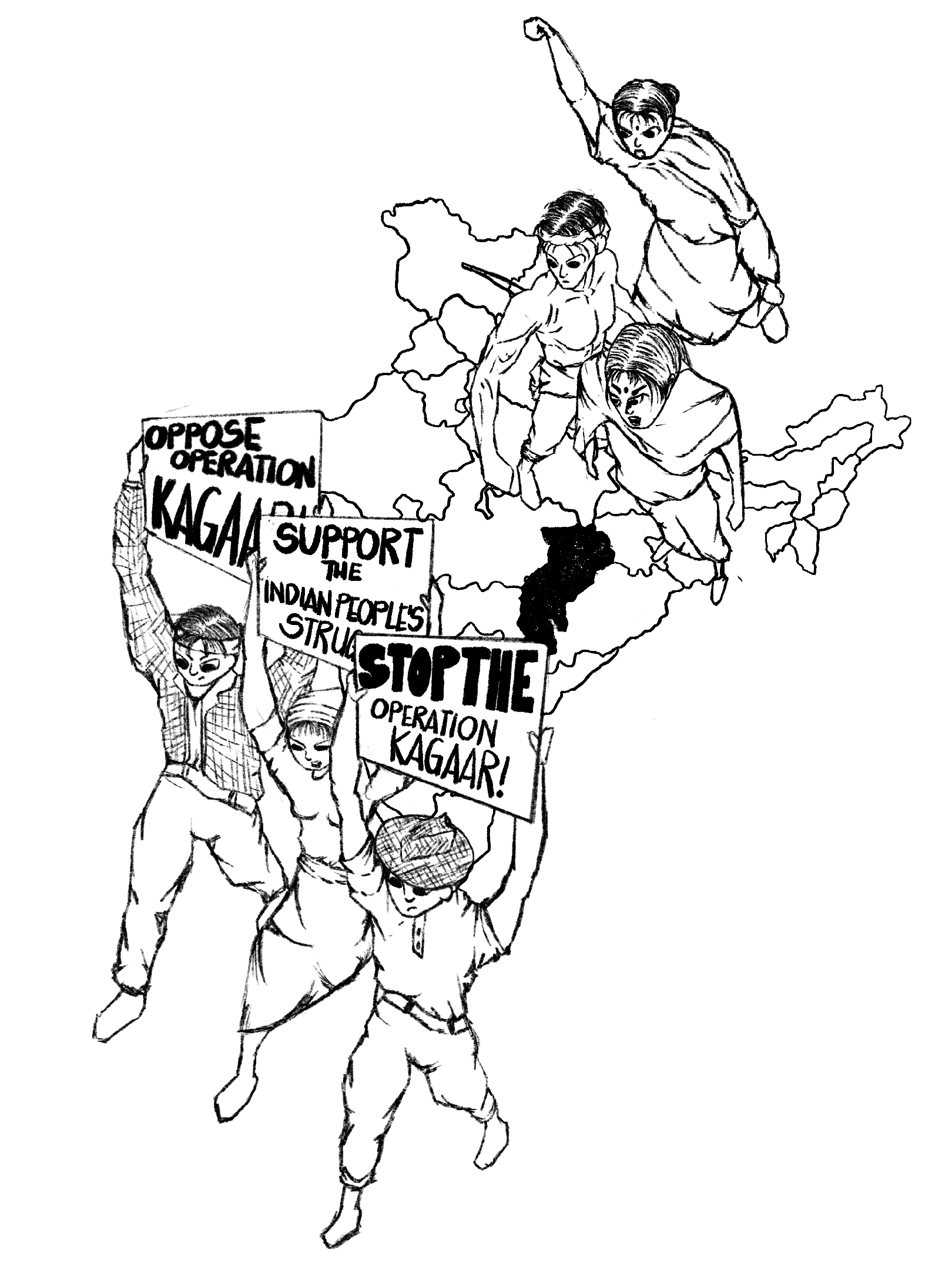
IV. People’s resistance
Amid Indian state fascist attacks and repression, the Adivasi, human rights defenders and democratic organizations are fighting continuously and valiantly. They are strengthening their campaign to drive out military camps from their communities through mass barricades and protests.
Organizations from other states and centers are conducting fact-finding missions to expose the crimes committed by the Indian state against the communities under attack. Students and teachers are protesting in the Indian capital of Delhi to expose the human rights violations among wider youth and people.
Alongside these, the PLGA and CPI (Maoist) are making efforts to hit and attack the Indian state fascist troops and armed forces. At least 35 elements of the Central Armed Police Force (CAPF) and the special COBRA (Combat Battalion for Resolute Action) unit were killed in action during a PLGA raid on a camp in Darmavaram, Pamed, Bijapur, Chhattisgarh on January 16. In addition, 40 more police were seriously injured in the attack.
The revolutionaries also attacked the construction of a bridge in Maad, in Narayanpur district, Chhattisgarh on February 1. The guerrillas immobilized a tractor, a tanker and a concrete mixer. The construction of the bridge, like other “development projects” in Maad, is paving the way for the entry of big corporations to plunder the area’s natural resources.
The PLGA and CPI (Maoist) are steadfast allies of the Adivasi in Central India, fighting alongside them in their life-and-death struggle to protect their environment, land, and livelihood.
V. Key events in the history of the counterinsurgency campaign in India*
2005: Implementation of Salwa Judum
The Indian state formed Salwa Judum (Cleansing Campaign) militias from local Adivasi in Bastar, Chhattisgarh on the pretext of fighting Maoists. It unleashed terror in communities including many cases of rape, arson, and extrajudicial killings.
2009: Start of Operation Green Hunt
The Indian state launched a new phase of counterinsurgency using US imperialist training and tactics. It implemented the strategy of “winning the hearts and minds” of the Indian people, which actually worsened repression. It aimed to crush movements opposing and resisting the plunder of India’s natural resources. It allowed the entry of large foreign and domestic corporations into the resource-rich regions of the country.
2011: Banning Salwa Judum
The Indian Supreme Court banned the prevailing state-backed Salwa Judum vigilante militias and confirmed its village burning, gang rapes and genocidal concentration camps. This ruling proved the accumulated human rights violations perpetrated against Adivasi and peasant masses.
2014: Failure of Operation Green Hunt
Operation Green Hunt’s brutality and heaping human rights violations were fully exposed. Democratic organizations launched a strong campaign against the operation.
2015: New experiment in Surjagarh hills
The Indian state implemented a new series of corporatization and militarization in the Surjagarh mountain ranges in Gadchiroli, Maharashtra. It targeted anti-mining movements and people’s struggles against imperialist plunder.
2017: Operation SAMADHAN-Prahar
The new counterinsurgency campaign Operation SAMADHAN-Prahar was launched. It expanded the Surjagarh experiment to regions of India which are rich in natural resources.
2018: Bhima Koregaon-16 arrests
Mass arrests of 16 activists, professionals, human rights defenders and minority people related to the Bhima-Koregon case. They were implicated in the “violence” that occurred at a gathering in December 2017 in Bhima Koregaon, Pune district of Maharashtra. The amended and intensified Unlawful Activities (Prevention) Act of 2019 was used against them. This marked the start of successive attacks on anyone standing up and speaking out against the state.
2021: First recorded case of aerial bombing
For the first time in India, the state used Israeli-made drones to drop bombs on Adivasi communities. Many more cases of aerial bombing were recorded after this incident.
2022: Formation of Surajkund Scheme
The Surajkund Scheme was formed at a meeting of top Indian bureaucrats in October 2022 in Surajkund, Haryana state. It is the result of the reactionary Indian state’s summing-up of the 5-year implementation of Operation SAMADHAN-Prahar. It expanded its implementation of Operation SAMADHAN-Prahar and officially sanctioned the use of aerial bombs against Adivasi communities, primarily in Bastar.
The scheme targetted not only “communists” but also those labeled as “terrorists” and “organized crime” by the state. The Brahmanic Hindutva regime uses it to attack Maoists, opposition, Muslims, and political rivals.
2024: Implementation of Operation Kagaar
Operation Kagaar began in Abujhmaad in central India
*Source: Forum Against Corporatization and Militarization (FACAM)
_____
Prepared by:
Information Bureau,
Communist Party of the Philippines
June 2024




